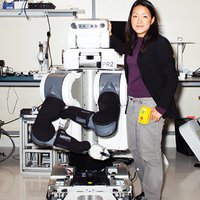Chris Harrison recently helped develop an invention, called Touché, that can turn practically anything into a computer input device—a table, a doorknob, a pool of water, your hand. To do this, he relies on the natural conductivity of some things, or he adds electrodes to objects that aren’t conductive. Then he wires up a controller that registers the range of electronic signals the objects generate when they are changed by, say, a particular hand gesture or body posture. A sensor attached to a sofa, for instance, can continuously monitor voltage changes to detect the signatures of particular motions and events and link them to actions. A dog leaping on the couch might trigger a harsh noise to scare it off; a person sitting down might cause the TV to switch on. (Yes, even a couch potato’s life can be made easier.)
Harrison, a PhD student in Carnegie Mellon’s Human-Computer Interaction Institute, says his mission is to liberate our fingers from having to command our phones and other devices by poking at squished keyboards and teensy screens. “If you think about all the ways we use our hands, being limited to only poking would make the world really hard to use,” he says.
He is enlisting technologies ranging from cameras to stethoscopes to miniature projectors. Before Touché, which he developed while at Disney Research, he invented a device called Skinput that turns skin into the equivalent of an interactive touch screen: a tiny body-mounted optical system projects “buttons” onto the wearer’s hand and arm and detects any tapping of the buttons so that a device can be controlled. As an intern at Microsoft, he helped create OmniTouch, a roughly similar system that makes it possible to turn any object in the environment into a multitouch screen. And he’s made a device called Scratch Input that uses a modified stethoscope and generic microphone to convert the sound of a fingernail dragging over just about any surface into an electrical control signal.
Harrison notes that as computers become better integrated into almost everything we do, we will find it increasingly convenient to be able to interact with them in a variety of ways, without always having to resort to a screen or keyboard. “Eventually we’ll develop input technologies so good that we don’t need a touch screen,” he says. Our tired fingers salute that quest.
—Nicole Dyer




